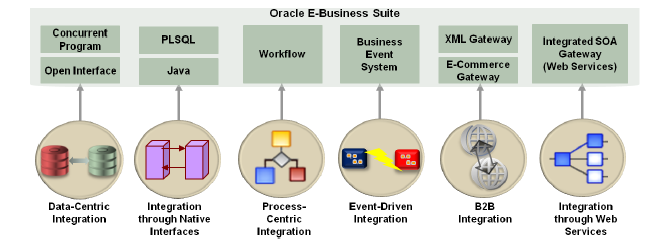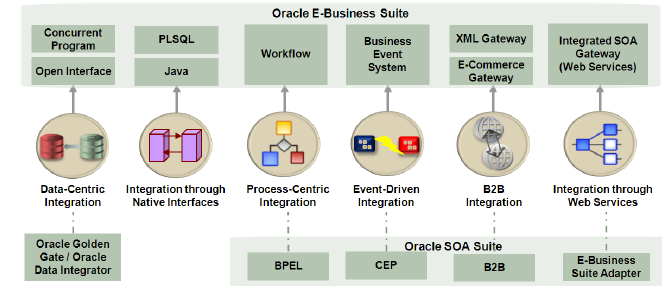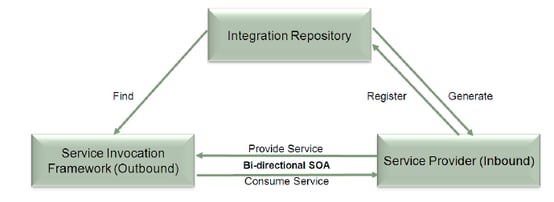Enterprise Integration – An overview of different integration approaches
Enterprise Integration – An overview of different integration approaches
As enterprises are evolving at a very rapid pace the usage of different heterogeneous applications is proliferating and hence an integration between these systems becomes a vital part of the operations.
Enterprise Integration Styles
• Data-centric integration
• Integration through native interfaces
• Process-centric integration
• Event-driven integration
• B2B integration
• Integration through Web services

Oracle E-Business Suite provides a robust set of native technologies and products to address each of the above integration styles.

For many of the integration technologies and products from Oracle E-Business Suite, there are optional products from Oracle Fusion Middleware that add on value to the integration.

Data-centric Integration
Data centric integration is the process of consolidating, managing, and moving information from different data sources, including databases, data files, and applications such as ERP, CRM, legacy, and data warehouses.
Technologies used
- Open Interface Tables, Views, and Concurrent Programs
- Oracle XML Gateway and Oracle E-Commerce Gateway
- Oracle XML Gateway and Oracle E-Commerce Gateway use open interface tables, views, and concurrent programs for outbound transactions.
- SQL Loader
- Oracle Golden gate
- Works against the change data capture logs of databases and can work across a heterogeneous database landscape
- Oracle Data Integrator ( ODI)
- Works directly against the database tables and uses an extract, load, and transform approach to handling data.
Integration through Native Interfaces
APIs are interfaces that an enterprise application developer exposes to provide access to application logic, business rules, and data. Customers can then use these APIs to build, customize, and extend the enterprise application for their usage. An example of using native interfaces is creating an application wrapper that saves additional custom information in custom tables with application-specific information.
Technologies used
PL/SQL and Java APIs
Oracle E-Business Suite publishes APIs that can be used to create or update business objects, re-use seeded business logic and rules, and retrieve business data. These APIs are native technologies and are suitable for working within the network; they are not suitable for integration across instances using remote invocations across networks. These APIs are recommended for Oracle E-Business Suite customization's and extensions.
Process-centric Integration
A business process is a coordinated set of business functions that may be driven by human actions or governed by automated business rules. Complex business processes may involve multiple enterprise applications, whereas simple processes happen within one application, such as a performance appraisal process within an HR application.
Technology used
Oracle Workflow
Oracle Workflow provides a workflow management system that supports business process-based integration within Oracle E-Business Suite applications. It enables modelling, automation, and continuous improvement of business processes, routing information of any type according to user-defined business rules. Oracle Workflow Builder provides a graphical drag-and-drop process designer.
Event-driven Integration
Event-driven integrations can address the requirement to allow asynchronous actions or initiate a long-running offline business process on the occurrence of a business event. This type of integration is also used to monitor key business events and status updates. It provides a non-intrusive mode of enterprise application integration. For example, an enterprise application can raise a business event whenever a purchase order is created or updated. Interested parties can subscribe to this business event and depending upon business rules sends an alert or notification to the floor manager on stock levels.
Technology used
Oracle Workflow Business Event System
The Oracle Workflow Business Event System provides event-driven processing in Oracle E-Business Suite. On occurrence of a business event in Oracle E-Business Suite, the Business Event System triggers event subscriptions that specify the processing to execute for that event. Subscriptions can include the following types of processing:
• Executing custom code on the event information
• Sending event information to another workflow process
• Sending event information to named communication points called agents on the local system or external systems
• Sending event information to a Web service as a SOAP request
B2B Integration
B2B is the integration of an enterprise application and its business processes with external business applications operated by customers, suppliers, and trading partners. Business data are exchanged between trading partners in standard format. These integrations are driven by industry-level standards such as OAG, IFX, and EDIFACT
Technology used
Oracle XML Gateway and Oracle E-Commerce Gateway
Oracle XML Gateway is a product from Oracle E-Business Suite that facilitates the bidirectional communication of business critical data between Oracle E-Business Suite applications and third party applications or trading partners in the form of well-formatted XML messages. It is used to generate and consume DTD-based XML messages triggered by business events. These XML messages can be exchanged with trading partners through any of three communication modes – Oracle Transport Agent, Web services, or JMS. Oracle XML Gateway leverages Oracle Workflow, the Business Event System, Oracle Advanced Queuing, and other database components.
Integration through Web Services
Heterogeneous and hybrid IT environments are common in today’s enterprises. In a heterogeneous environment, applications are built on different technology platforms, operating systems, and programming languages. In a hybrid enterprise environment, the enterprise uses both on-premise and cloud-based applications. Integration through Web services is the recommended integration approach for such environments.
Web services provide interoperability between applications running on disparate platforms. The fundamental specifications that Web services are based on are SOAP (Simple Object Access Protocol), WSDL (Web Services Description Language), and UDDI (Universal Description, Discovery, and Integration). SOAP, WSDL, and UDDI are XML-based, making Web service protocol messages and descriptions human readable. These SOAP messages are transported over the standard internet transport protocol, HTTP/HTTPS.
Web service-based integration addresses the following requirements:
• Integrating enterprise applications from different vendors
• Integrating enterprise applications built on different technologies
• Integrating enterprise applications with business or trading partner applications
• Point-to-point system integration with loose coupling of participating applications
• Integrating on-premise enterprise applications with on-cloud or hosted enterprise applications
Technology used
Oracle E-Business Suite Integrated SOA Gateway
Oracle E-Business Suite Integrated SOA Gateway is a SOA-based integration infrastructure product from Oracle E-Business Suite that helps organizations to provide, consume, and monitor Web services for integrations in a heterogeneous ecosystem. It has four major components –Oracle Integration Repository, Service Provider, Service Invocation Framework, and Service Administration

Service Provider (for inbound) – In Oracle E-Business Suite Integrated SOA Gateway, Service Provider exposes the public integration interfaces as standard Web services. Interfaces of the following types can be exposed as SOAP-based Web services: PL/SQL, Concurrent Program, XML Gateway, Business Service Object, and Java APIs for Forms (a subset of Java APIs).
When Service Provider receives a SOAP request for an Oracle E-Business Suite Web service, it ensures that the request is authenticated against JAAS-based security and authorized against Oracle E-Business Suite function security. It supports both Username Token (in Plaintext) and SAML Token (Sender Vouches) based authentication types. Valid Web service requests are executed by the underlying Oracle E-Business Suite API. The response from the API is sent as a SOAP response to the calling Web service client for a synchronous interaction pattern.
Service Invocation Framework (for outbound) – The Oracle E-Business Suite Integrated SOA Gateway Service Invocation Framework (SIF) provides the ability to invoke any third-party external public Web service that is exposed and available for consumption through the standard Web service communication mode of SOAP over HTTP. The response can be consumed by Oracle E-Business Suite through any of the following:
• Oracle Workflow process
• Oracle Forms
• PL/SQL API
• OA Framework page
• Java program
• Java or PL/SQL based Concurrent program Enterprise Integration – An overview of different integration approaches
To know more about our integration practice click on the following link https://www.oneglobesystems.com/integration
